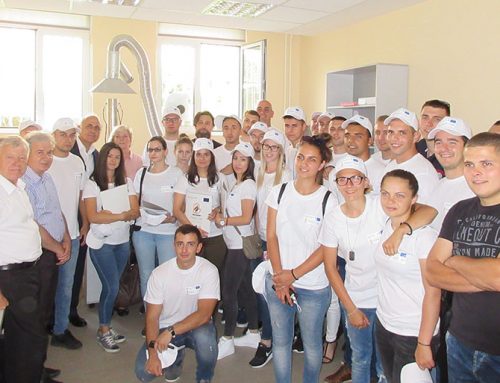One doctor and seven nurses have been taking special care of patients suffering from terminal illnesses in the area of Cacak in the last six months. In the Palliative Care Unit at the General Hospital in Cacak, Dr. Danka Dragicevic and her colleagues have dedicated themselves to the patients and their families 24 hours a day. There are no specified visiting hours in the Unit, visitors can come at any time and stay as long as they wish. Doors depicting open arms and butterflies are always open to family members to visit their loved ones who receive around the clock care. While in Serbia palliative care has been developing for over a decade, the major progress in this field was achieved in the last three years with the financial support of the European Union (EU) through the project “Development of Palliative Care in Serbia”, financially and strategically supported by the Ministry of Health.
“Illness is the will of God, and if it is a man’s fate to die, he will die”
– Orhan Pamuk
More than 80 patients from Cacak and the surrounding area have passed through this department in less than six months since its opening. Patients with serious illnesses, chronic progressive diseases accompanied by chronic pain, cancer patients, neurological, cardiology patients all come here…It does not have to be and is not just for dying patients. Sometimes they can still have months to live, but they share the diagnosis of a terminal illness. Care of patients in the period when death is imminent, care of dying patients and families during the period of mourning-are just a part of palliative care. The main objective is to improve the quality of life, because the outcome of the illness can no longer be affected, nor can they be cured, but the quality of life of patients and of their relatives can be improved.

Palliative care provides relief from pain and other distressing symptoms affirms life and regards dying as a normal process, intends neither to hasten or postpone death but to enhance quality of life, and may also positively influence the course of illness. It also offers a support to help patients live as actively as possible until death and helps the family cope during the patient’s illness and in their own bereavement.
Since 1910 when it was erected, the building which now houses the Department of Palliative Care in Cacak has had a turbulent past. It used to be a kitchen, then the X-ray room, it was used for dialysis, and since December 2013, it became the Department of prolonged treatment and care- Palliative Care Unit. With the financial support of the Ministry of Health, the building was renovated and modernly equipped.
Patients in palliative care are looked after by a “great team that collaborates with a social worker, psychologist, priest…as required palliative care-a multidisciplinary approach to the patient,” said Dr. Nada Lazovic, deputy director of the Health Centre in Cacak. This department receives patients from all over the Moravski district, the municipalities of Cacak, Gornji Milanovac, Guca, Lucani. Good cooperation has been established with doctors from the primary health care centres, who are the first to encounter the patients that are referred to this department. Patients are receiving pain treatment, are admitted when they have a loss of appetite, insomnia, after chemo and radiotherapy, when suffering from depression.
The palliative care unit is a facility that can provide active, specialist palliative care interventions for patients who require treatment and stabilisation of significant symptoms. Average length of stay in these units is 2-3 weeks, but is often shorter. It is important to note that it is not a long term care facility, and patients requiring long term care should be transferred to a long term care facility.”Patients can stay in this department on average two to three weeks when their condition deteriorates. The Department provides services to families and caregivers who care for the patient. We give them advice on how to help the patients to have the best possible quality of life, “explains Dr. Lazic.
In order to be better prepared to accommodate the patients, “Standard Operating Procedures for Palliative Care” were developed, with all the instructions and procedures which staff adhere to: from admission to discharge of the patient. The doctor does the assessment of needs for palliative care, assesses the patient and makes a pain assessment. Separate records are kept on each patient. After discharge, some patients go home, some are transferred to other hospital departments or are placed in a rehabilitation centre. Unfortunately, some of them die.

“People think that this is a place to come to die, but this is not a ward for dying. We help patients when their condition worsens. They spend a few days with us, which means a lot to their families. Patients are satisfied with the care they receive. The nurses feed them, take them outside, hold their hand if necessary all night long. It’s hard not to get attached to these patients, but that’s life. Sometimes we are contacted by family members whose loved ones have died,” explains Dr. Danka Dragicevic.
Before she started working in this department, this young doctor worked in the ER, and then “chose palliative care.” She and her colleagues (six nurses and a young technician Predrag Paunovic) have undergone special training which was provided in the framework of the EU project. Everything they learned was meaningful because now they have a “clear vision” of how to work. “This is my vision of medicine – to help others,” says young Paunovic proudly.
Slobodan K, 54, from Cacak, who is suffering from lung cancer, has spent six days in the department. When they brought him he could not eat or walk. He was given pain therapy and his condition has improved even though he has a terminal illness. “I did not even know that this department existed with such wonderful staff. So young, and yet so capable… I wish that such services existed in the whole of Serbia. Here they talk to me, and I only need a word, nothing more. I feel great, as if I didn’t have cancer. They brought me back to life,” says this Cacak native.
On June 26, 2014, a Coordinating body for palliative care was established that will function within the framework of the Council for Health of the city of Cacak. This will improve palliative care, create a network of cooperation with institutions at the local level, and patients and their families will be provided with the necessary assistance and support.
Total pain
The philosophy of the modern hospice was created in the middle of the last century in London based on the vision of Dame Cicely Saunders, who during the Second World War, volunteered in two old hospices in London. There she learnt that morphine should be administered at regular intervals, and realised that if it was administered to a patient regularly every four hours, later the need for morphine would be considerably smaller, and that patients with such treatment would have a much better quality of life. Understanding the other needs of these patients, of a psychological, social and spiritual nature, she developed the concept of “total pain” and she established the first modern hospice, “St. Christopher’s,” in London in 1967, where she merged the earlier traditional care of dying patients with new medical advances in palliative care.
Read more about this project here



